
Nose piercing is the piercing of the skin or cartilage which forms any part of the nose, normally for the purpose of wearing jewelry, called a nose-jewel. Among the different varieties of nose piercings, the nostril piercing is the most common.

An earring is a piece of jewelry attached to the ear via a piercing in the earlobe or another external part of the ear. Earrings have been worn by people in different civilizations and historic periods, often with cultural significance.

An eyebrow piercing is a vertical surface piercing, wherein a twelve to eighteen gauge cannula needle is inserted through the bottom of the eyebrow and exits through the top of the eyebrow to permit insertion of jewellery. Those performing the piercing may use a pennington clamp to better guide the needle through the skin. A curved barbell is the most common jewellery inserted post-piercing.

Pearling or genital beading is a form of body modification, the practice of permanently inserting small beads made of various materials beneath the skin of the genitals—of the labia, or of the shaft or foreskin of the penis. As well as being an aesthetic practice, this is usually intended to enhance the sexual pleasure of partners during vaginal or anal intercourse.
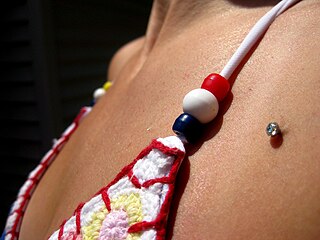
Transdermal implants, or dermal piercings, are a form of body modification used both in a medical and aesthetic context. In either case, they consist of an object placed partially below and partially above the skin, thus transdermal. The skin around it generally heals as if it were a piercing.

A subdermal implant is a body modification placed under the skin, allowing the body to heal over the implant and creating a raised design. Such implants fall under the broad category of body modification. Many subdermal implants are made out of silicone, either carved or mold injected. Many people who have subdermal implants use them in conjunction with other types of body modification to create a desired, dramatic effect. This process is also known as a 3-D implant, or pocketing.
In modern Western body piercing, a wide variety of materials are used. Some cannot be autoclaved, and others may induce allergic reactions, or harbour bacteria. Certain countries, such as those belonging to the EU, have legal regulations specifying which materials can be used in new piercings.
A transscrotal piercing is a body piercing that travels through the scrotum from front to back, or from side to side. It is a high risk procedure.
Body piercing jewelry is jewelry manufactured specifically for use in body piercing. The jewelry involved in the art of body piercing comes in a wide variety of shapes and sizes in order to best fit the pierced site. Jewelry may be worn for fashion, cultural tradition, religious beliefs, personal symbolism, and many other reasons.
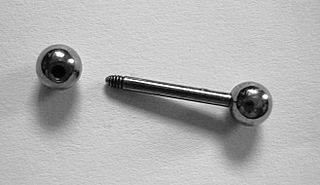
Barbell style piercing jewelry is composed of a straight bar with a bead on each end, one or both beads unscrewable for removal and/or changing of the beads. Often one of the beads is fixed, either via epoxy or welding, so that only one bead is used to install or remove the jewelry. Barbell threads are usually right-handed.
Stretching, in the context of body piercing, is the deliberate expansion of a healed piercing for the purpose of wearing certain types of jewelry. Ear piercings are the most commonly stretched piercings, with nasal septum piercings, tongue piercings and lip piercings/lip plates following close behind. While all piercings can be stretched to some degree, cartilage piercings are usually more difficult to stretch and more likely to form hypertrophic scars if stretched quickly. Dermal punching is generally the preferred method for accommodating larger jewelry in cartilage piercings.
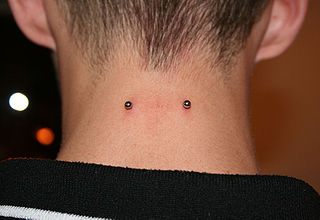
A nape piercing is a piercing through the surface of the nape of the neck. Nape piercings are a type of surface piercing. They carry a high rate of rejection and migration, unless they are properly measured and placed. They may reject if they are not pierced properly, as they are in a part of the body that moves constantly and are easy to irritate, catching on clothing or other objects.

Piercing migration is the process that occurs when a body piercing moves from its initial location. This process can be painful or go unnoticed, until it has progressed. Given enough time, a ring may migrate entirely outside of the skin, although it may only migrate a small amount and come to rest.

A corset piercing is a body piercing that consists of multiple piercings in rows, usually on the back, with ribbon or string laced through to mimic the appearance of a corset. Two rows of bilaterally symmetrical piercings are performed and can be composed of as few as four piercings or as many as the length of the area being pierced and the vertical space between piercings will allow space for. Due to the difficulty and risks associated with permanently healing single surface piercings, most corset piercings are intended to be temporary.
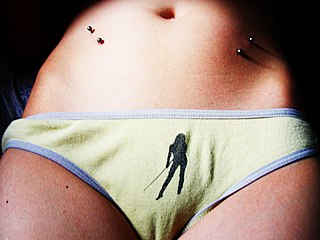
A hip piercing is a piercing in the pelvic area through the skin near the hip bone. Hip piercings are often done in couplets with one on each hip, but it is not unusual to see only one. Hips piercing are a type of surface piercing. Microdermals or skin divers can be implanted in the hip area to give a similar appearance.
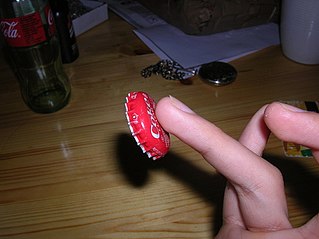
Magnetic implant is an experimental procedure in which small, powerful magnets are inserted beneath the skin, often in the tips of fingers. They exist in tubes and discs. This procedure is popular among biohackers and grinders, but remains experimental. Magnetic implants are often performed by amateurs at home, using readily available surgical tools and magnets found online. However, some professional body modification shops do perform implant surgeries. Magnetic implants can also be used as an interface for portable devices to create other new "senses", for example converting other sensory inputs such as ultrasonic or infra-red into a touch sensation. In this way the individual could 'feel' e.g. the distance to objects.

A plug, in the context of body modification, is a short, cylindrical piece of jewelry commonly worn in larger-gauge body piercings. Modern western plugs are also called flesh tunnels. Because of their size—which is often substantially thicker than a standard metal earring—plugs can be made out of almost any material. Acrylic glass, metal, wood, bone, stone, horn, glass, silicone or porcelain are all potential plug materials.
A wrist piercing is a piercing through the surface of the wrist, first popularized by Jon Cobb in PFIQ. Wrist piercings are a type of surface piercing. They carry a high rate of rejection and migration, unless they are properly measured and placed. The piercings may be rejected if they are not installed properly; due to the location of the piercings they are easy to irritate, and regularly catch onto clothing or other objects. People with wrist piercings are advised to put on short sleeved t-shirts, singlets so as to prevent the surface barbell from catching onto the threads of the clothing. Also, wrist piercings can only be done with a special tool and thus, it is of high difficulty for it to be home-made. Piercers would also advise that, after getting a wrist piercing, the person is to soak and moisten the wound with mild salted solution so as to disinfect the area, preventing bacteria from entering the unclotted wound. The span of a wrist piercing ranges approximately from as short as 2 weeks to 6 or 7 months.
Steve Haworth is a body modification artist based in Phoenix, Arizona. He is responsible for the invention and popularization of subdermal and transdermal implants, such as the "Metal Mohawk". He designed specialized medical instruments called dermal elevators for this process. He has also done pioneering work with surface bars, ear shaping, tongue splitting, magnetic implants, and artistic branding. He has worked on individuals noted for their extensive modifications such as The Enigma, Katzen, Stalking Cat, The Lizardman, and biohacker Tim Cannon. He is listed in the Guinness World Records as "Most Advanced Body Modification Artist", 1999 to present.













